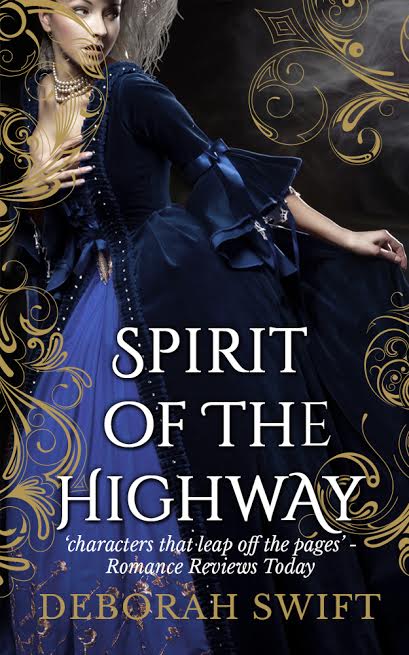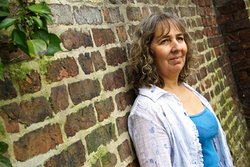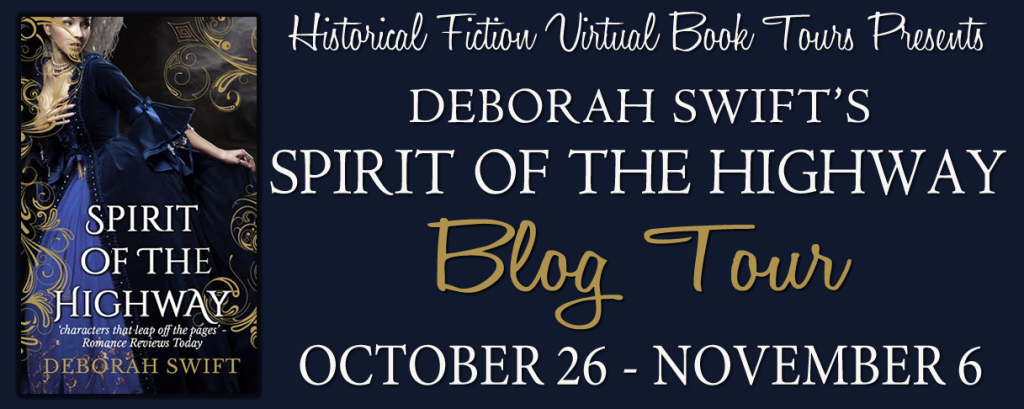Pallbearers, Grave Plots and Corpse Lights by Deborah Swift
My most recent novel, Spirit of the Highway, is narrated by a ghost, and as we are coming up to All Hallows Eve I thought it would be appropriate to share some information on seventeenth century funerals.
By the late seventeenth century the English were said to be famous for cheap weddings but extremely lavish funerals. It was not unusual for burials to be in the evening after the working day. Flambeaux-lit processions were de rigueur and mourners were supplied with black gloves, mourning rings, crepe hatbands and other trappings to denote their respect for the deceased. It must have been quite a sight to see this weaving its way through the village.
Funerals were an excuse to get together as a community, and before and after setting out it was customary to drink goblets of red wine laced with sugar and cinnamon, or spiced ale. This could be why the funerals took so long! And in fact they began to take so much time that an attempt was made to regulate them, and it was made law in 1689 that no funeral should last more than two hours. Those who did not obey this rule were fined and the proceeds given to the poor.
On the day of the funeral, the body was draped in a pall or ‘mort cloth’. The mort cloth was often velvet, sometimes with a rich lining, embellished with symbolic embroidery, and laden with gold thread and heavy fringes. Fortunately these could be hired, with simpler palls for the less well-off. Pall-bearers were often furnished with white silk scarves. Other mourners carried nosegays or sprigs of rosemary. Rosemary, with its pungent, slightly antiseptic smell no doubt hid bodily odours and was associated with remembrance. The sprigs were scattered into the grave as the body was covered in earth. Coffins were not universal, but became a cheaper alternative to hiring a mort-cloth, and soon gained in popularity.
Whether you died a Catholic or a Protestant, the clergy were notorious for demanding outrageous fees; In 1641 Katherine Childley complained that to have a child buried in London would ‘cost the poorest parent seven or eight shillings,’ and even for the unfortunate inmates of Bedlam charges of more than a shilling were common. Average middling class earnings were about £5 a year, so Katherine Childley would have been paying out a substantial part of the family income to bury her child. Sometimes clergymen refused to bury the corpse unless paid in advance! In 1605 in one poor parish, Agnes Betson refused to pay the 15 pence demanded for the burial of her child.
Often relatives were more closely united in death in the family plot than they ever had been in life. Some wealthy men requested burial alongside the paternal line, rather than with their spouse, which indicates a strong adherence to the class systems of the day over and above the intimacy of married life. Wealthy families liked to be interred in the actual church, supposedly closer to God, but this was more expensive as it involved taking up flagstones. It could only be sanctioned for the most wealthy and high status families.
Richard Browne complained of this practice of ‘making churches charnel houses being of ill and irreverent example, and prejudicial to the health of the living, besides the continual disturbance of the pavement and seats, the ground sinking as the carcases consume, and several other indecencies.’
A rich variety of folklore and custom was associated with death and burial. Common superstitions surrounding death were a belief that the spirit of the deceased escaped through the mouth. The mouth was therefore often stopped with herbs or coins once the spirit had departed. Bells were tolled to prevent the ghost’s return and to frighten away evil spirits. Nine bells for a man, six for a woman and three for a child.
The feet of the corpse had to be kept pointing away from the family home on its journey to the church, to prevent the deceased wanting to walk back home. Also the route often went over bridges or stepping stones across running water which it was believed spirits would not be able to cross. The corpse light, the supposed soul of the dead, was supposed to linger on these roads, and there were many accounts of people seeing them, for ghosts and spirits were widely accepted as part of everyday life right up until the 20th century.
 |
| Markate Manor |
About the Book

Spirit of the Highway (Highway Trilogy, Book II) by Deborah Swift
Publication Date: September 30, 2015
Endeavor Press
eBook & Paperback; 292 Pages
Genre: Historical Fiction/Young Adult
England 1651.
England has been engaged in a bitter Civil War for nearly ten years. Ralph Chaplin, a farmer’s son, has fallen for beautiful copper-haired Kate. There is only one problem – he is a Roundhead soldier and she is a Royalist lady.
Tired of bloodshed, Ralph volunteers to fight, sensing that the Battle at Worcester will be a chance to finish the fighting for good. He longs for peace, so he can forge a secure future and find a different, more equal way of life for himself and Kate.
But war is not what he imagined, and soon he has made a deadly enemy; one who will pursue Ralph and those he loves, and wreak vengeance. What’s more, Ralph finds he has just as many enemies at home, as on the battlefield.
Told by Ralph’s ghost, Spirit of the Highway is the stand-alone second part of the Highway Trilogy based on the real life and legend of Lady Katherine Fanshawe, highwaywoman and heiress.
Praise for Deborah Swift
"The past comes alive through impeccable research, layers of intriguing plot line, an understanding of the complexities of 17th century politics and the sheer power of descriptive prose." -Lancashire Evening Post"characters you can really get interested in" -The Mum website
Praise for Shadow on the Highway (Book One, Highway Trilogy)
"Shadow on the Highway is an awesome work of YA historical fiction. It is definitely my new favorite Deborah Swift book!" -So Many Books So Little Time Blog"Swift brings layers of historical and imaginative detail to her stories and I highly recommend as a light read for any adult and for teenagers interested into foraying into historical fiction." -Hook of a Book Blog
"Shadow on the Highway is an exciting peek into the English Civil War from both sides of the fighting... I very much look forward to the next two books in this trilogy!" -Historical Tapestry
 About the Author
About the Author
Deborah Swift is the author of three previous historical novels for adults, The Lady’s Slipper, The Gilded Lily, and A Divided Inheritance, all published by Macmillan/St Martin’s Press, as well as the Highway Trilogy for teens (and anyone young at heart!). Her first novel was shortlisted for the Impress prize for new novelists.She lives on the edge of the beautiful and literary English Lake District - a place made famous by the poets Wordsworth and Coleridge.
Blog Tour Schedule
Monday, October 26Guest Post at Passages to the Past
Tuesday, October 27
Review at Book Nerd
Spotlight & Excerpt at Let Them Read Books
Wednesday, October 28
Review at History From a Woman's Perspective
Thursday, October 29
Review at With Her Nose Stuck in a Book
Monday, November 2
Review at The Maiden's Court
Tuesday, November 3
Spotlight & Excerpt at Brooke Blogs
Thursday, November 5
Review at One Book Shy of a Full Shelf
Friday, November 6
Review at Bookramblings
Review at Just One More Chapter
Guest Post at One Book Shy of a Full Shelf
Giveaway
To win a signed paperback of Spirit of the Highway please enter the giveaway via the GLEAM form below. Three copies up for grabs!Rules
– Giveaway ends at 11:59pm EST on November 6th. You must be 18 or older to enter.
– Giveaway is open internationally.
– Only one entry per household.
– All giveaway entrants agree to be honest and not cheat the systems; any suspect of fraud is decided upon by blog/site owner and the sponsor, and entrants may be disqualified at our discretion
– Winner has 48 hours to claim prize or new winner is chosen.
Spirit of the Highway




















I saved this till I could read it. Fascinating information! Love the strange superstition about the feet of the corpse.
ReplyDelete